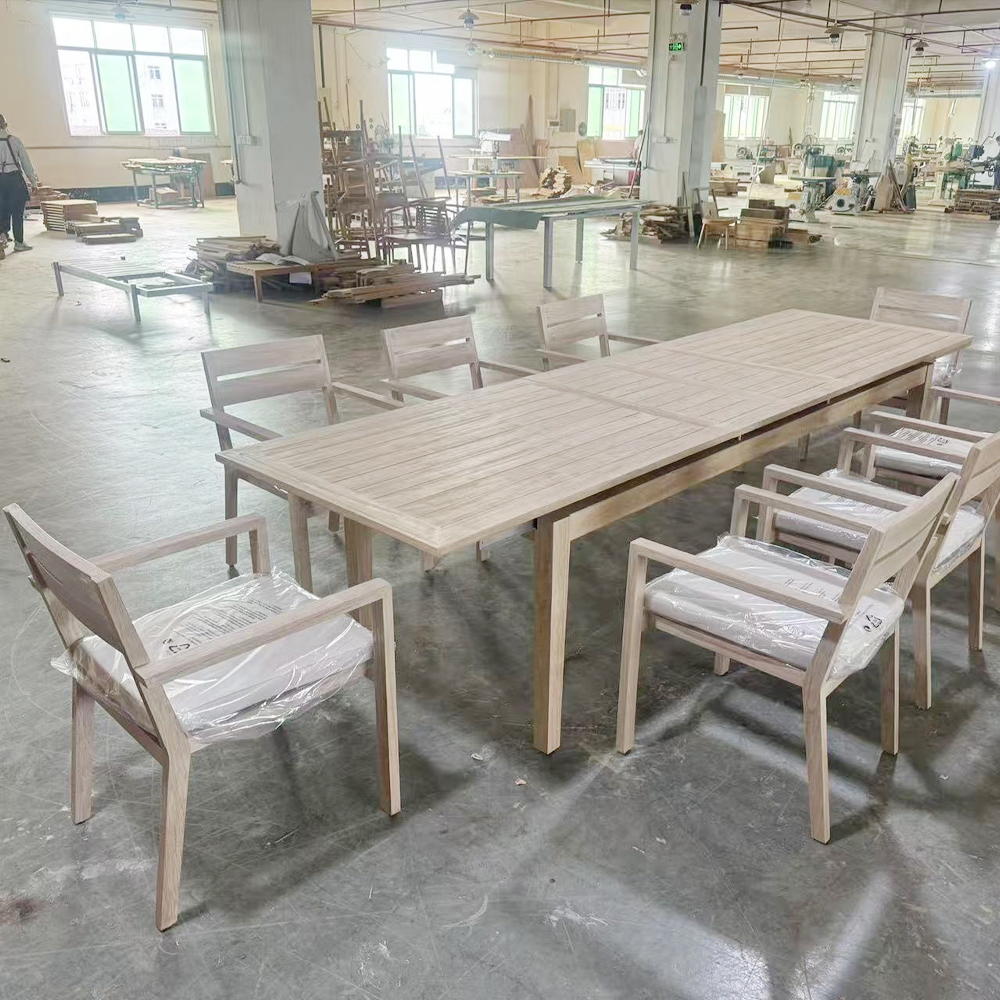Ultimate Guide to Outdoor Tabletop Materials: Durability, Aesthetics & Practicality
Choosing the right tabletop material is critical for outdoor furniture longevity. We break down 11 options used in luxury patios, coastal resorts, and commercial spaces.
1. Teak Wood (Grade-A FSC Certified)
Core Identity: The gold standard for organic elegance.
Natural Weather Shield:
23–25% natural oil content forms a self-replenishing barrier against moisture, preventing rot/swelling. Unlike pressure-treated woods, it never oozes toxic chemicals.
Marine-Grade Resilience:
Tectol rubber compounds repel insects and salt corrosion. Proven in yacht decks and Bali beach clubs where lesser woods fail within 2 seasons.
Zero-Maintenance Aging:
Sun exposure transforms golden hues into prized silvery patina (no sanding needed). Apply teak oil annually only if restoring original color.
Structural Superpowers:
Density (680kg/m³) supports 250kg+ without sagging. Thermal stability (-20°C to 80°C) prevents cold-cracking—critical for mountain resorts.
Design Tip: Pair with powder-coated bases for coastal settings. Avoid glass tops—teak’s tactile warmth is part of its luxury.
2. Natural Marble
Core Identity: Timeless geological artistry.
Nature’s Unreplicable Canvas:
Unique veining patterns like Calacatta Gold or Carrara Grey. Each slab is a million-year-old natural sculpture.
Weight = Stability:
70–90kg/m² density anchors furniture in windy locales. Heat-resistant (up to 120°C)—ideal for pizza oven adjacencies.
Critical Care Notes:
Porosity demands sealing: Annual impregnation prevents wine/oil stains. Not for acid-rain-prone industrial zones.
3. Engineered Marble (Solid & Veneer)
Core Identity: Controlled beauty for pragmatists.
Type A (Solid Polymer Composite):
93% crushed marble + 7% resin.
UV-stable colors (limited to 15 classic shades).
Scratch-resistant surface tolerates grill tools.
Type B (Veneer Over MDF):
Avoid in full-sun/rain: Delaminates in 18–24 months.
Budget solution for covered terraces only.
Pro Alert: Specify "full-body" engineered marble for commercial projects. Veneers void warranties in monsoon climates.
4. Sintered Stone (2CM/3CM)
Core Identity: Space-age mineral surface.
Performance DNA:
14,500 psi compression strength (vs. marble’s 4,000 psi). Resists UV fading, acid spills, and -30°C freeze-thaw cycles.
Zero-Porosity Hygiene:
Bacterial growth impossible—mandatory for poolside bars and hospitals.
Installation Edge:
Only 1.2cm thickness needed for 2m spans. Reduces shipping weight by 40% vs. stone.
5. Aluminum Sheet (1.5–3mm)
Core Identity: Industrial sleekness.
Aircraft-Grade Options:
5052-H32 (bendable for curved tops) or 6061-T6 (for load-bearing dining tables).
Powder-Coated Armor:
Polyester coatings withstand 1,500+ salt-spray hours (ASTM B117). Match RAL colors to umbrellas.
Heat Dissipation:
Reflects 80% solar radiation—stays touchable in 45°C deserts.
6. Aluminum Slat (20x100mm profiles)
Core Identity: Ventilated modernity.
Drainage Genius:
8mm gaps between slats prevent water pooling. 10° tilt option for rainy climates.
Structural Rigidity:
Interlocked with hidden T-slot systems. Holds 150kg dynamic load (tested to EN581).
Eco Bonus:
100% recyclable. Uses 95% post-industrial scrap.
7. GRC (18–25mm)
Core Identity: Brutalist durability.
Formula Science:
Cellulose fiber-reinforced Portland cement with acrylic modifiers.
Project Hero:
Custom sizes up to 3m x 1.5m without seams. Water-based paint in 200+ RAL colors.
Vandal-Proof:
Withstands impacts from falling coconuts/branches. Lifespan: 25+ years.
Contractor Tip: Specify for high-volume beach resorts. Saves 30% vs. stone with faster installation.
8. Tempered Glass (5/8/12mm)
Core Identity: Invisible structure.
Safety First:
12mm laminated option cracks into harmless crumbs (ANSI Z97.1).
Stealth Mounting:
Nearly invisible clamp systems create "floating" effect.
Climatic Limits:
Avoid in hail-prone areas. Requires weekly cleaning in pollen-heavy zones.
9. Stone-Effect Glass (8–12mm)
Core Identity: Luxury illusion.
Digital Print Magic:
Ceramic frit patterns replicate marble/onyx with 0.3mm texture depth.
Cost Reality:
$290/m² (vs. $90/m² for standard glass). Justified in photo-op zones like rooftop bars.
UV Endurance:
Inorganic pigments resist fading for 10+ years.
10. HPL (High-Pressure Laminate)
Core Identity: Pattern playground.
The Outdoor Deception:
Most "outdoor HPL" fails in 3 years. True exterior-grade requires:
Core: Resin-saturated cellulose (ISO 4586-2)
Top Layer: Electron-beam cured acrylic
Edges: PVC-wrapped or aluminum capped
Commercial Reality:
Costs $15–20/sf for certified marine-grade (e.g., Trespa Meteon®). Cheaper to use aluminum.
11. Wood-Plastic Composite (WPC)
Core Identity: Eco-mainstream.
Recipe Truth:
Quality brands use 60% hardwood flour + 40% virgin HDPE (avoid recycled fillers).
Thermal Expansion Trap:
Expands 2mm/m in summer—demands 10mm gap between boards.
Stain Resistance:
Superior to teak for barbecue splash zones.
Material Selection Cheat Sheet
Material Best For Avoid In Lifespan Cost/m² (USD)
Teak Coastal, Luxury Resorts Budget Projects 25+ years $380+
Sintered Stone Poolside, High-Traffic Curved Designs 30+ years $420+
Aluminum Slat Rainy Climates, Minimalist Formal Settings 20+ years $260+
Fiber Cement Large Projects, Vandal Zones Detailed Carvings 25+ years $180+
Stone-Effect Glass Instagrammable Spaces Hail Zones 12–15 years $290+
Pro Recommendations
Coastal VIPs: Teak + Aluminum bases (zero corrosion)
5-Star Hotels: Sintered stone (stain-proof)
All-Weather Cafés: Aluminum slats (self-draining)
Volume Developers: Fiber cement (custom colors + bulk discounts)
Design with climate realities—not just aesthetics.

